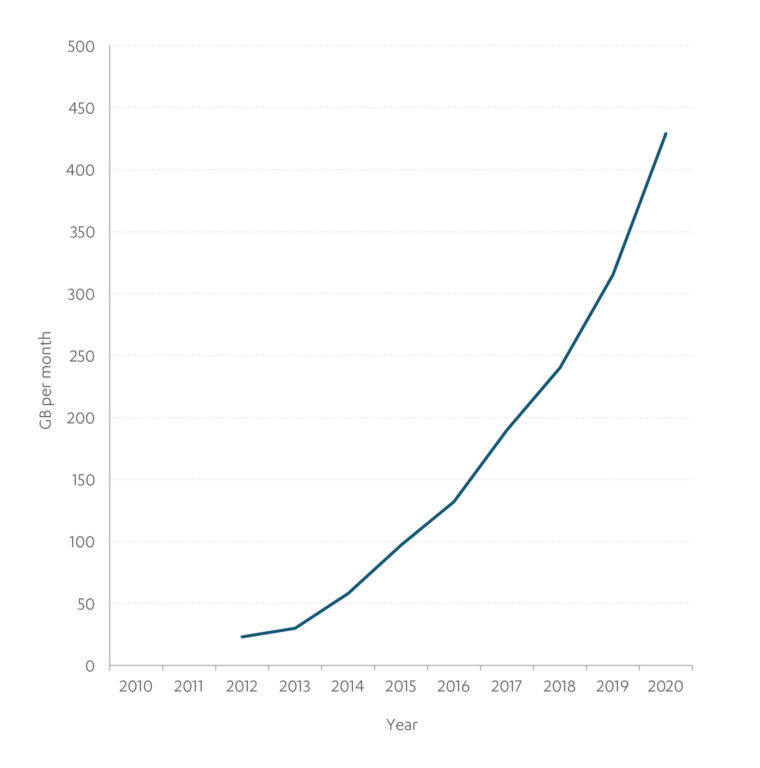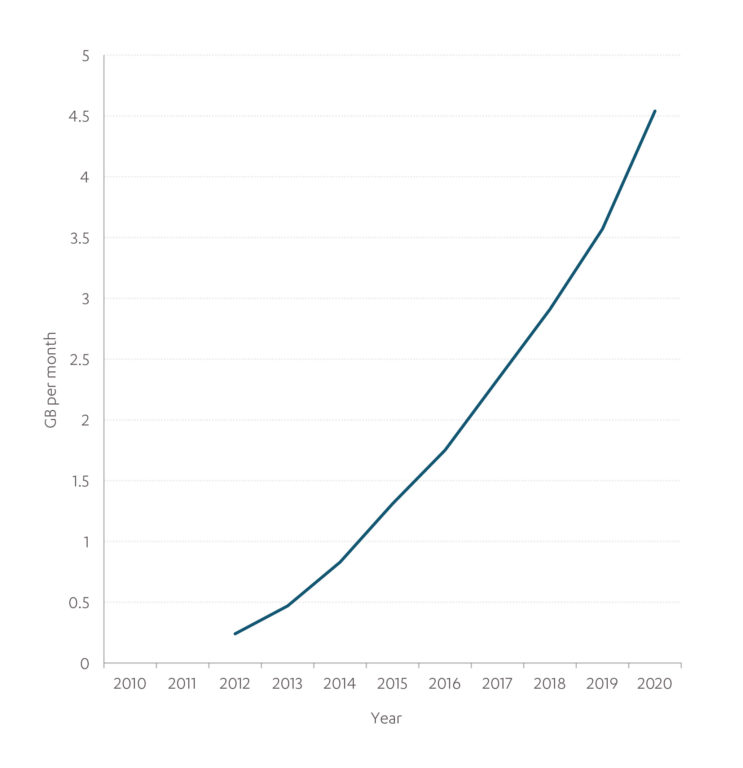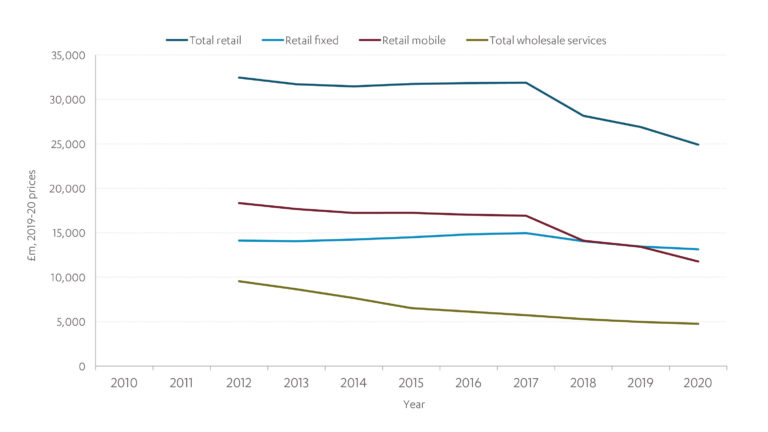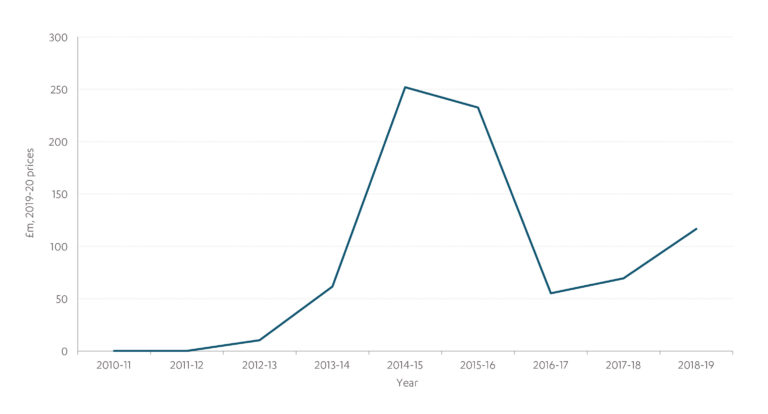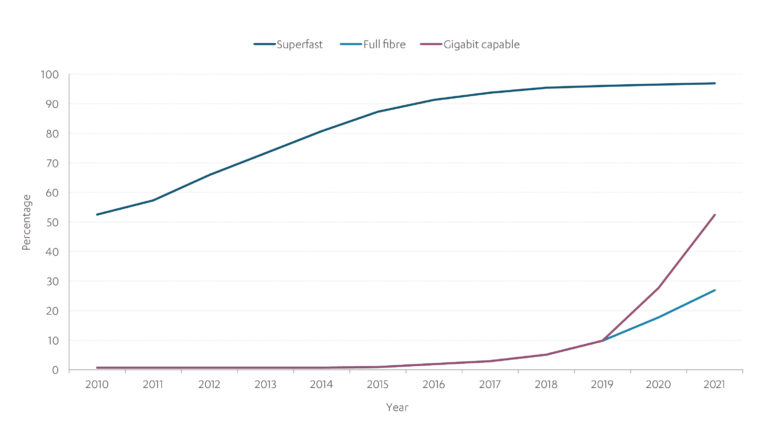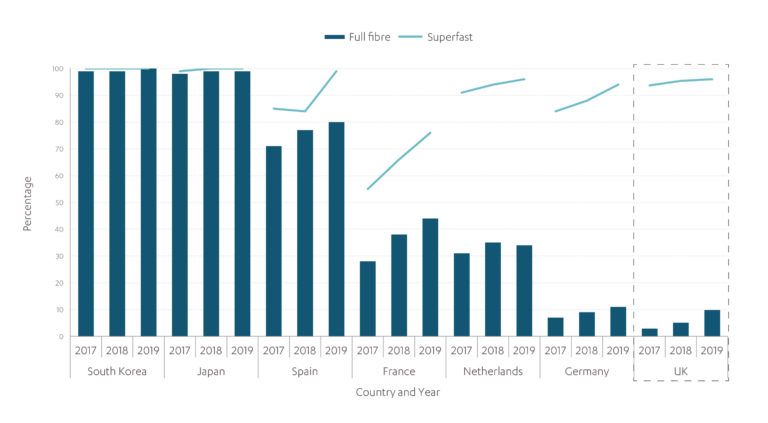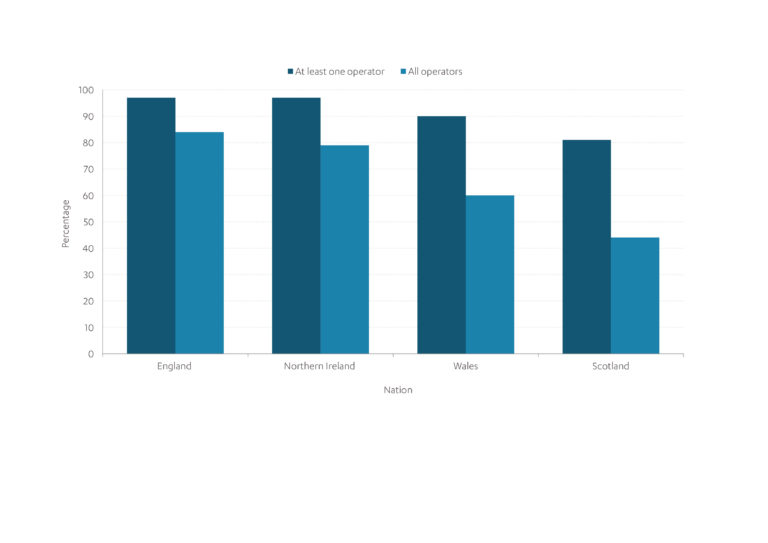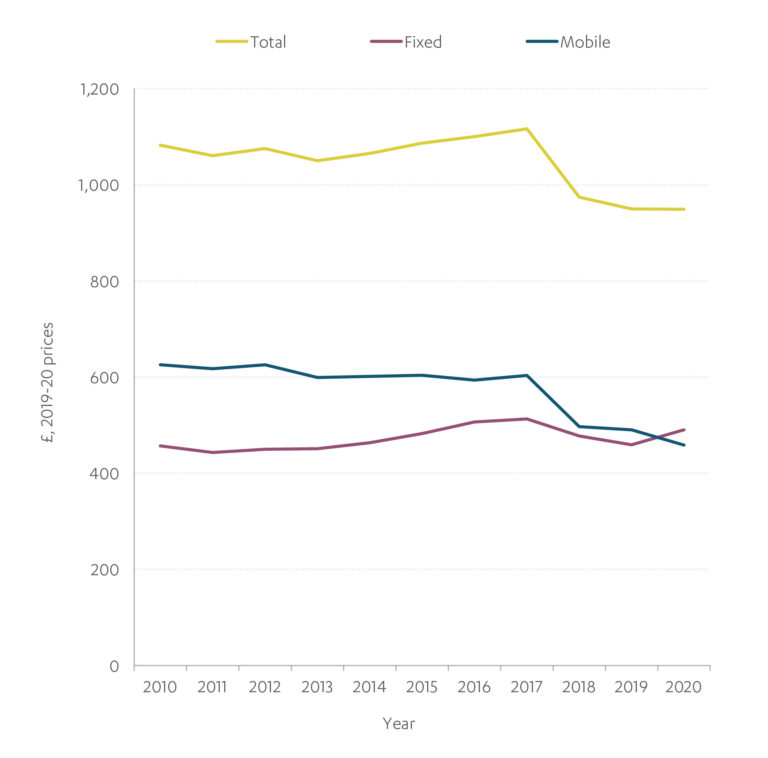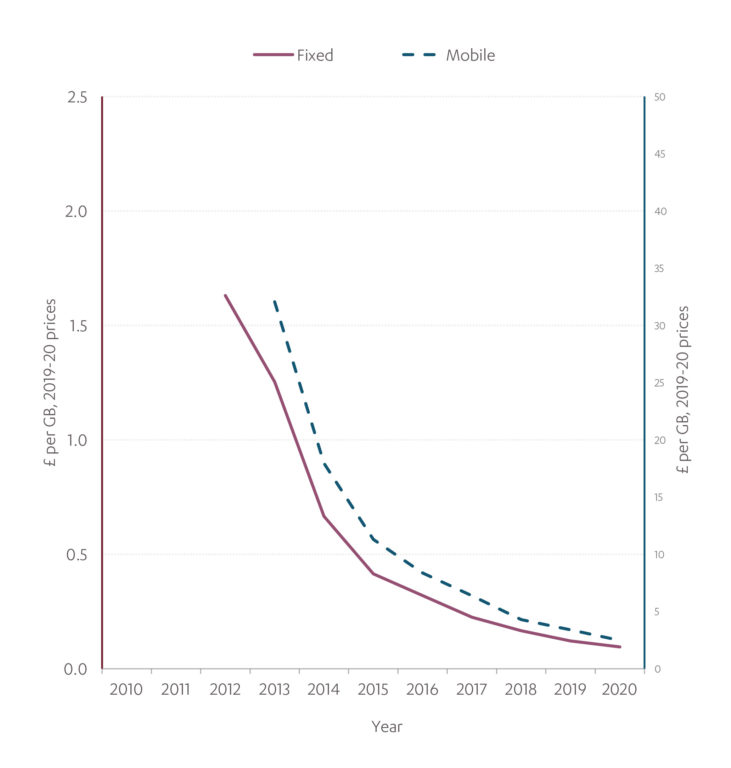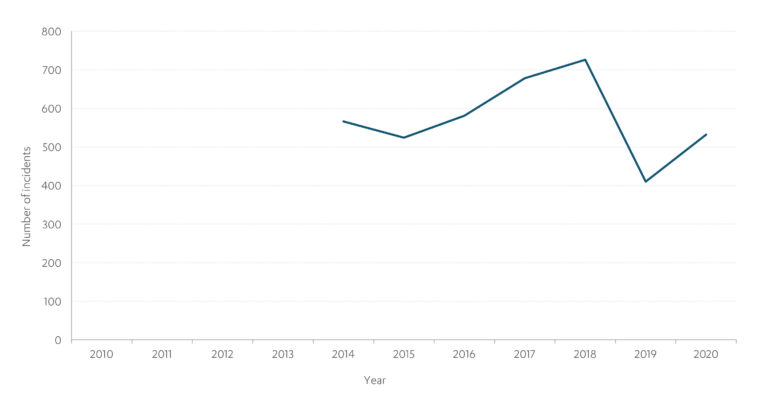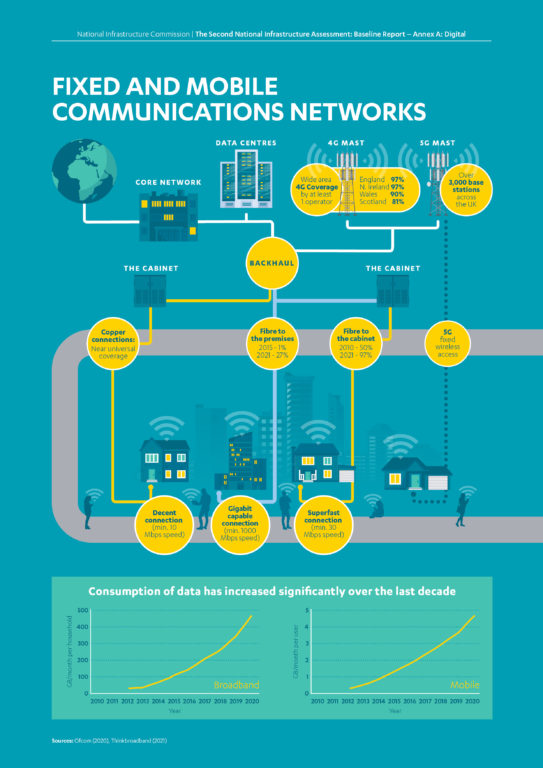Baseline Report Annex A: Digital
Analysis of the UK's digital infrastructure which informs the Second National Infrastructure Assessment: Baseline Report.
Tagged: Digital & Data
Sector overview
Digital connectivity has become a necessity, with broadband and mobile services linking homes and businesses across the UK.
Demand for data, and therefore the speed, reliability, and capacity of broadband connections, is growing rapidly. Demand will continue to increase as businesses, homes and all types of economic infrastructure become smarter. The Covid 19 pandemic accelerated these trends and reinforced the fact that the provision of fast and reliable digital connectivity is now almost as central to society and the economy as the supply of electricity or water.
Digital infrastructure consists of various interconnected networks which are owned and operated by different companies. Broadly, these networks are split into three different levels:
- The core network is the backbone of the digital communications networks and is the “intelligent” part of the network, which identifies where the network’s subscribers are and ensures that data is sent to the correct user. It connects an operators’ network directly to the backbone of the internet.
- The backhaul is the middle of the network and consists mostly of high capacity transmission lines that connect the core network to the local exchanges for fixed broadband or wireless base stations for mobile connections.
- The access network links directly to an end user’s equipment, such as routers or mobile phones, and connects them to the backhaul network. Access networks for broadband include copper and fibre connections to premises, and for mobile connections, consists of networks of base stations.
Digital infrastructure is a complex and interdependent system of systems, but the infrastructure covered by the Commission focuses on those services that are accessed by consumers and businesses and broadly splits into two categories: fixed broadband and mobile connections.
Fixed broadband connections
Fixed broadband provides a continuous connection to the internet for homes and businesses, replacing previous ‘dial up’ connections. To use home broadband, customers usually connect devices wirelessly to a WiFi router. The router is connected through the wall to broadband cabling technology, which is normally supplied to the premises via a street cabinet. The cabinet in turn connects via more cables to the exchange, which is part of the internet service provider’s network. There are a range of different service levels that fixed broadband can provide (see figure A.1), depending on which access technology is used:
- Copper (ADSL)1 consists of a copper cable connecting the exchange to the cabinet and the cabinet to the premises. Copper networks are only capable of providing a basic level of connection and can be unreliable. Actual speeds delivered by copper connections diminish with distance.2
- Fibre to the cabinet consists of a fibre cable connecting the exchange to the cabinet but a copper cable connecting the cabinet to the premises. Fibre to the cabinet can provide superfast connections but, like ADSL connections, is susceptible to faults and actual speeds diminish with distance between the cabinet and the premises.3
- Hybrid fibre coaxial cable involves connecting the exchange to the cabinet with fibre cable but then connecting the cabinet to the premises with a coaxial cable, which is a form of copper based cabling.4 The latest standard of cable technology — DOCSIS 3.1. — can provide gigabit connections, however in practice the speeds that users receive can be slower5
Full fibre to the premises consists of a fibre connection from the exchange all the way to the premises, normally bypassing the cabinet. It can provide gigabit connections and can be more reliable than the other technologies.6 Generally, distance to the premises does not affect the speed delivered and localised congestion can more easily be avoided.
| Type of service | Minimum speed (Mbit per second) | Example activities that service can support |
|---|---|---|
| Decent broadband | At least 10 (download) and 1 upload | Making video calls, downloading a one hour episode of high definition television (HDTV) in around 15 minutes |
| Superfast | 30 to 300 (download) | Capable of supporting multiple devices at once, downloading an episode of HDTV in around four minutes |
| Ultrafast | 300 to 1000 (download) | Multiple people streaming ultrahigh definition TV at once, downloading an episode of HDTV in less than 30 seconds |
| Gigabit | 1000 and above (download) | Capable of downloading a high definition film in under one minute or a full 4K film in less than 15 minutes |
Mobile data and voice connections
Mobile networks provide telephony and data connectivity services to consumers by using a mobile phone as a terminal. Like fixed broadband, there are a range of different service levels that mobile connections can offer, as shown in figure A.2. Mobile access network infrastructure consists of two main elements:
- The radio access network: The network of base stations providing cellular coverage across the UK, allowing mobile devices to transmit and receive data via the radio spectrum. Base stations vary in size and cost, but each requires an appropriate site with a power supply and a fibre or microwave connection to the backhaul network.
- The radio spectrum: Part of the electromagnetic spectrum, and is widely used for modern day telecommunications, broadcast TV and radio. Information can be transmitted over different frequency bands within the radio spectrum. The radio spectrum is a finite resource and so bands are allocated to users, such as the Mobile Network Operators, by Ofcom which has a duty to ensure that the spectrum is efficiently used.
| Type of service | Description |
|---|---|
| 2G | The oldest available technology deployed in the UK, now mainly used for telephony services |
| 3G | The first generation of service that enabled the use of internet services |
| 4G | The most widely accessed technology, capable of delivering reasonable capacity broadband for video streaming |
| 5G | The latest generation of mobile communication technologies, with the potential to provide ultrareliable, low latency and very high capacity connectivity that can support new use cases across areas such as transport and the industrial Internet of Things |
Convergence of fixed and mobile connections
Although broadband is normally provided via a cable it can also be provided wirelessly through a service known as ‘fixed wireless access’. Currently, three of the four Mobile Network Operators offer fixed wireless access, as do many of the Wireless Internet Service providers, who use other radio spectrum bands. Fixed wireless access is offered on 4G and 5G networks, usually to an indoor router. Based on the Mobile Network Operators’ claimed coverage, at least 95 per cent of UK premises have access to a fixed wireless connection, although the vast majority of this is accessed through a 4G rather than 5G device.7 However, due to capacity constraints and localised issues, the quality of this service may be limited.
Fixed wireless access can also be provided by satellites. This is particularly important for premises where no other connection type is available. However, connections provided by geostationary satellites are often poor quality due to the distance between the satellite and the premises it is connecting to.8 Current capacity is also limited, and the cost of supply connections can be high.9 This may change as more low earth satellite constellations are deployed, such as Starlink and Open Web, which are closer to premises and therefore can provide better quality.10
Usage of fixed broadband and mobile connections
Consumption of data has grown dramatically over the past decade, both for fixed and mobile connections. Figure A.3 shows that consumption from fixed connections increased from around 25 gigabits per month in 2012 to around 430 gigabits per month in 2020, while consumption of mobile data increased from 0.25 gigabits per month in 2012 to around 4.5 gigabits per month in 2020. Fixed broadband data consumption is significantly higher, which is partly because most consumers typically use it for data heavy activity such as higher resolution video streaming.
Figure A.3: Data consumption has increased rapidly over the past decade
Annual fixed data consumption per household
Annual mobile data consumption per user
Source: Ofcom (2021), Communications Market Report 2021
Digital infrastructure and the Commission’s remit
The Commission’s remit covers the infrastructure required to deliver telecommunications, primarily focusing on the infrastructure needed to deploy both fixed and mobile connections. In addition, the Commission also considers how the application of digital infrastructure, and the collection and analysis of data, can facilitate more effective delivery of services in the other infrastructure sectors within its remit.
As digital infrastructure policy is a reserved matter, the Commission’s remit covers England, Scotland, Northern Ireland and Wales.
Governance and regulation
Fixed broadband connections
In the United Kingdom, fixed broadband infrastructure is largely privately owned and operated. There are separate wholesale access and retail markets in fixed broadband products designed for residential and business consumers (for example, managed high-capacity services based on leased lines).11 As explained in section A.1, broadband services are typically provided over a local access network and there are different local access network technologies, each with different capabilities.12 The retail broadband market is characterised by strong competition with end users able to choose from a range of services (figure A.4).
The two main networks providing access services to residential and business customers across the UK are BT (operated by Openreach, its wholly owned, independent fixed access infrastructure arm) and Virgin Media O2. Due to the historical development of telecoms networks in the UK, BT is the incumbent provider and has the largest national network. In 2017 BT agreed to the legal separation of Openreach. To promote competition, Openreach is required to provide regulated access to its network to other broadband providers such as Sky, Talk Talk, and BT’s own retail division.13
Openreach mainly supports superfast broadband services using fibre to the cabinet connections, which are available across most of its national network. However, it has also been upgrading its access network by deploying full fibre connections and has set a target of delivering this to 25 million premises by 2026.14
Virgin Media O2 operates a network that largely offers hybrid coaxial connections, although they intend to move to a full fibre to the premises network by 2028.15 It currently reaches around 15 million premises across the UK, mainly in urban areas.16 Virgin Media O2 is vertically integrated, but unlike BT, does not at present provide competitors with access to its network. This network already supports ultrafast broadband services and is in the process of being upgraded to provide gigabit speeds by end of 2021.17
There is a growing number of alternatives to these two networks. For example, KCOM operates a network solely in the Hull area and CityFibre provides full fibre infrastructure on a wholesale only basis in over 40 cities across the country.18
Figure A.4: Fixed broadband connections by internet service provider19
| Name of provider | Share of retail market (per cent) |
|---|---|
| BT | 34 |
| Sky | 23 |
| Virgin Media O2 | 19 |
| TalkTalk | 11 |
| Others | 13 |
Mobile connections
There are four Mobile Network Operators which own and maintain mobile networks and hold spectrum licences to support their operation. Infrastructure sharing agreements exist between them, with joint ventures between EE and Three (Mobile Broadband Network Limited),20 and between O2 and Vodafone (Cornerstone Telecommunications Infrastructure Limited).21 O2 and EE, owned by BT, are also involved in the provision of broadband connections. Both of these joint ventures also access infrastructure owned by third parties, known as Wholesale Infrastructure Providers. This sharing of infrastructure assets both between the Mobile Network Operators and with third party infrastructure owners allows for economy of scale savings.
Mobile retail services are mainly provided by the four Mobile Network Operators who make up over 90 per cent of the retail market (see figure A.5). In addition, there are a number of Mobile Virtual Network Operators that offer services similar to the Mobile Network Operators but do not own the infrastructure or radio spectrum that delivers their services. Instead, they enter into agreements with the Mobile Network Operators to use parts of their infrastructure. For example, Tesco Mobile has [6] per cent of the UK mobile provider retail market (see figure A.5) but uses O2’s infrastructure.22
Figure A.5: Mobile subscriber market share by provider23
| Name of provider | Share of market (per cent) |
|---|---|
| Mobile network operators | |
| EE (including BT) | 28 |
| Virgin Media O2 | 30 |
| Vodaphone | 21 |
| Three | 12 |
| Mobile virtual network operators | |
| Tesco | 6 |
| Sky | 1 |
| Other | 2 |
Note for row one, EE24
Policy
Policy and legislative responsibility for the digital sector lies with the Department for Digital, Culture, Media and Sport. In 2018 government published the Future Telecoms Infrastructure Review which set out a new policy framework to accelerate the rollout of gigabit capable broadband and 5G mobile networks in the UK.25 This new policy framework promoted stable and long term regulation to incentivise network investment and competition, alongside steps to reduce the barriers to network deployment.
Government has set targets for deployment for both gigabit capable broadband and 5G mobile network coverage for the mid 2020s. For gigabit capable broadband, government’s target is to reach at least 85 per cent coverage of gigabit broadband by 2025 and seek to accelerate rollout further to get as close to 100 per cent as possible.26 On 5G, the government’s ambition is for the UK to become ‘a world leader in the next generation of mobile technology, 5G, with deployment to the majority of the country by 2027’.27
While digital infrastructure policy is a reserved matter, the devolved administrations play a role in delivering broadband under government policy programmes and have allocated significant funding to support deployment.28
Ofcom is the regulator and competition authority for communications services in the UK, including digital infrastructure. It has a statutory duty to further the interests of citizens and consumers, where appropriate by promoting competition. Since its inception in 2003, Ofcom has focussed on promoting competition in retail broadband services through regulated wholesale access to BT’s copper networks. This has been largely successful in creating a competitive retail market for broadband services in the UK. In recent years, Ofcom’s regulatory approach has shifted towards promoting competition and investment in gigabit-capable networks. Ofcom must have regard to the UK government’s statement of strategic priorities for telecoms and spectrum when exercising its regulatory functions.29
In March 2021 Ofcom published its Wholesale Fixed Telecoms Market Review, setting out measures to incentivise investment in full fibre network infrastructure – giving regulatory certainty and allowing companies to make a fair return while ensuring consumers continue to have access to affordable broadband as new networks are rolled out.30
Box A.2: The copper switch off
Transitioning to full fibre broadband will allow the legacy copper network to be switched off. Running both a copper network and a fibre network would add significantly to the overall costs of digital infrastructure.31 While switching off the copper network is ultimately a commercial decision for Openreach, action from Ofcom is needed to facilitate it.
To support this, Ofcom has implemented rules to transfer regulation of charges from copper to fibre in geographic locations with high levels of fibre coverage.32 Since June 2021, Openreach has been able to stop selling new copper based services in areas where full fibre or cable coverage has reached a total of 75 per cent of premises.33 Furthermore, from June 2023, in areas where full fibre or cable coverage reaches 100 per cent of premises, parts of the copper network can begin to be decommissioned.34
Funding and financing
Funding
Digital infrastructure, for both fixed and mobile connections, is predominately paid for by end user subscriptions to broadband and mobile services. There has been a steady decline in revenue over the last five years in the retail fixed and mobile markets. Figure A.6 shows that total revenue fell from £32 billion in 2012 to £26 billion in 2020. This was driven by increasing competition in the fixed and mobile retail markets, which pushed down prices.35 The proliferation of ‘over the top’ services — those offered directly to consumers via the internet, such as WhatsApp — have also reduced retail mobile revenues as consumers move away from traditional call and SMS messaging services.
As shown in figure A.6, the wholesale market is significantly smaller than the retail market and only makes up around 15 per cent of total telecoms revenue.
Figure A.6: Revenues in the retail market have declined slightly over the last decade
Revenues for the fixed and mobile retail markets
Source: Ofcom (2021), Communications Market Report 2021
Financing
Investment in mobile and fixed connections is mostly made by private companies. Investment in telecoms infrastructure tends to go in cycles as networks are upgraded with the latest technologies.
Overall investment in the telecommunication sector has been increasing over recent years.36 The increase was driven by the rollout of superfast broadband to most premises in the UK and the expansion of the country’s 4G mobile networks as smartphones have been widely taken up, which is discussed further in the next section.
The next wave of investment will support the deployment of gigabit broadband and 5G networks. In 2019, £3.5 billion was invested in fixed connections, £1.5 billion in mobile connections, and £0.7 billion in infrastructure to provide both fixed and mobile connections.37 The nationwide roll-out of nationwide gigabit broadband is a major civil engineering challenge and will require a significant amount of investment.
However, there is also some government investment in digital infrastructure (figure A.7), mainly to support the rollout of new technologies to hard to reach areas. Over the last decade, investment peaked in 2014-15 due to spending on the Superfast Broadband Programme to reach 95 per cent of premises.38 The primary programmes for government investment across the UK are:
- Superfast broadband programme: In 2010, government announced the Superfast Broadband Programme, which aimed to deliver superfast broadband to areas of the country that would not be covered by the commercial rollout. Around £800 million of government funding was allocated to deliver coverage to at least 95 per cent of UK premises. (see chart A.8).39
- Project Gigabit: In March 2021, the government announced Project Gigabit, a £5 billion fund to support the rollout of gigabit capable broadband to homes and premises in hard to reach places.40 The fund is designed to support the government’s aim of delivering a minimum of 85 per cent gigabit capable coverage by 2025.41 Spending Review 2020 allocated £1.2 billion of this funding for the years 2021 – 2025.42
- Shared Rural Network: In 2020, government secured the Shared Rural Network agreement with mobile network operators. The agreement aims to increase 4G coverage by at least one operator to 95 per cent of the UK landmass, and coverage from every operator to 90 per cent of UK landmass by 2026. The deal includes up to around £500 million of public investment, which is matched by up to around £500 million of private sector investment.43
- 5G Testbeds and Trials Programme: The 5G Testbeds and Trials Programme is providing up to £200 million in public funding to trial 5G use cases in order to reduce the risks of business models and encourage private sector investment.44
Both private sector and government investment is expected to rise over the coming years. There is a wave of large scale capital expenditure in gigabit-capable networks as the incumbent operators, BT and Virgin Media O2, and new entrants race to roll out networks and capture market share. For example, BT, has reported that it will invest £15 billion to build 25 million full fibre to the premises connections by the end of 2026.45 All four mobile network operators in the UK launched 5G services in 2019, when – based on Ofcom’s analysis – investment in 5G access networks totalled around £175 million.46 This will only increase as the rollout of 5G speeds up. Government investment is also expected to rise again as money from Project Gigabit and the Shared Rural Network agreement, as described above, is spent in the 2020s.
Figure A.7: Government investment has been driven by the Superfast Broadband Programme
Government investment in digital 2010 – 2018
Source: Department for Digital, Culture, Media & Sport (2018), DCMS Annual Report and Accounts 2017-18 and Department for Digital, Culture, Media & Sport (2020), DCMS Annual Report and Accounts 2019-20
Performance of the sector
Summary of performance
The Commission has assessed the performance of each sector against four key criteria: quality, price, environment, and resilience. Against each of these, the UK’s digital infrastructure performs well overall and there has been significant progress since the first Assessment. However, there are areas where more needs to be done to ensure high quality connectivity is universally available.
In the past decade, the UK has rolled out new, higher quality, broadband technologies. The UK compares well internationally for superfast broadband availability at 97 per cent of premises, and almost all UK homes have access to a ‘decent’ broadband connection. However, it has lagged other European countries such as Spain, Portugal and France in terms of full fibre coverage, although it is catching up (see Figure A.9). If the UK’s policy and regulatory environment remains supportive of investment and network operators deliver on their published plans, government should meet its target of gigabit coverage reaching at least 85 per cent of premises by 2025.Mobile coverage has also expanded, with 4G coverage from at least one operator now available at around 92 per cent of the UK’s landmass and nearly all premises. This is expected to rise to 95 per cent by end of 2026 as a result of the Shared Rural Network Agreement. Coverage for both Scotland and Wales is significantly lower than the national average. The deployment of 5G infrastructure began in 2019, and since then over 800,000 users have taken up the service. However, it is not possible to say what this means in terms of how much landmass is covered, or how many premises. As the Commission set out in its 2021 Annual Monitoring Report government and Ofcom must work with the mobile network operators to identify suitable metrics and begin measuring actual 5G coverage.47
While average internet speeds and data usage have increased significantly , consumer bills have remained broadly the same. This means the value for money for consumers of both fixed broadband and mobile services has increased significantly.
Consumers of both fixed broadband and mobile connections report high rates of satisfaction. The Commission’s social research found that digital is the sector that the public is most confident will meet their needs over the next 30 years. In the latest research for the Commission, conducted in June 2021, 87 per cent of people were confident of this, compared to+ 81 per cent in 2017.48
The UK’s digital infrastructure demonstrated good resilience throughout the Covid 19 pandemic, despite a significant increase in demand for data. Government has recently introduced legislation aimed at ensuring the UK’s digital infrastructure is secure against cyber security threats.
However, there are some specific areas where performance is poorer. A limited number of households and businesses, around 134,000, still do not have access to even decent broadband speeds.49 While 4G coverage is generally good, there are still significant portions of the country that are not covered by all four operators,50 and coverage on the road and rail networks remains poor in some areas.51 The picture in individual nations varies significantly.
Quality
The quality of both fixed broadband and mobile digital infrastructure has been assessed based on the levels of coverage delivered, the take up achieved of these technologies and actual internet speeds for fixed broadband connections. Against these criteria, the UK’s digital infrastructure is performing reasonably well overall, but some challenges remain.
Fixed broadband connections
The availability of high quality broadband has increased significantly over the past decade. Superfast broadband is now almost universally available in the UK, with 97 per cent of premises having access (see figure A.8). Gigabit capable broadband, the next generation of broadband technology, is also being deployed rapidly, with availability rising from around five per cent in 2018 to over 50 per cent in 2021.52 This is driven predominantly through deployments by the larger infrastructure operators but supported by an increasing number of new entrants across the UK.53 Network competition and a supportive policy and regulatory environment are incentivising the rollout.
There are, however, a small number of premises, around 134,000, that do not yet have access to even a decent broadband connection (speeds of above 10 Mbit/second).54
Figure A.8: The availability of high quality broadband has increased significantly over the past decade
Proportion of premises with superfast, full fibre, and gigabit capable broadband available 2010 to 2021
Source: thinkbroadband (2021), UK Superfast and Fibre Coverage
The widespread availability of good digital connectivity is only the first step in realising the benefits of better quality digital infrastructure; these technologies also have to be used. In 2020, for those premises where superfast speeds or higher were available, around 60 per cent of premises actually took up these connections. Moreover, take up of services using full fibre at any speed, where full fibre is available, is around 25 per cent.55 Widespread take up of full fibre is important not just because it delivers better quality connections, but because it is needed to enable the copper switch off (see Box A.2).
The Covid 19 pandemic, which led to households increasing their demand for internet services, further accelerated take up for higher speed connections. Analysis from Ofcom suggests that over two million households have taken up a superfast broadband connection since November 2019.56
The increase in access and take up of higher quality connections has resulted in faster actual download speeds for consumers. Average download speeds for residential consumers have increased from around 20 Mbit per second in 2012 to around 80 Mbit per second in 2020.57 In 2020, nearly 80 per cent of all residential consumers has a download speed of at least 30 Mbit per second, and less than 10 per cent had a download speed of less than 10 Mbit per second.58
The UK is behind other comparable countries in deploying full fibre broadband, but it is catching up with strong progress in recent years (see figure A.9). Full fibre coverage has risen to almost 30 per cent in 2021. However, the UK does compare well against other countries on Superfast broadband coverage.
Figure A.9: Internationally the UK has good superfast coverage and is catching up on full fibre
Coverage rates for superfast broadband and full fibre broadband from 2017 to 2019 for the UK and comparator countries
Source: Ofcom (2020), The International Broadband Scorecard 2020
Consumer satisfaction with fixed connections is high. In Ofcom’s 2020 Consumer Satisfaction Tracker survey 78 per cent of respondents reported being either fairly satisfied or very satisfied with both the quality of their connection and its reliability.59
Mobile connections
Good progress has been made on delivering 4G mobile coverage and take up is high. Around 92 per cent of UK landmass is covered by at least one operator, up from 78 per cent in 2017. Moreover, at least 98 per cent of premises in the UK receive coverage from all operators.60 This has been matched by the widescale take up of smartphones providing ubiquitous access to 4G data services. The use of 3G data services now only constitutes a small part of the mobile data traffic.61
But some challenges do remain. While levels of landmass coverage by at least one operator are good, coverage by all four operators combined is significantly lower at 69 per cent, around 20 per cent short of the ambition government has set out in the Shared Rural Network agreement. There may also be issues with the availability of 4G in towns. As the Commission set out in Infrastructure, Towns and Regeneration, in some instances it appears that coverage predictions do not match real world user experience.62 This is likely driven by local factors, such as the position of trees or buildings, alongside the amount of congestion on the network. Ofcom and government should consider real world user experience data, alongside prediction models, to improve the understanding of how people experience mobile connectivity in different places.
Coverage on road and rail networks lags coverage of premises. 4G coverage from all operators is available on 65 per cent of motorways and A roads and 50 per cent of B roads.63 And while there is a lack of robust data, there are also well documented coverage challenges on the rail network.64 In 2016 the Commission recommended that the country’s motorways must have mobile telecommunication fit for the future and that rail passengers should have high capacity wireless connectivity.65 The Shared Rural Network Agreement should address some of this, as it aims to increase coverage on 16,000 kilometres of the road network.66
Figure A.10: Landmass coverage by at least one operator is high across all four nations
Percentage of landmass of the nations covered by 4G
Source: Ofcom (2021), Connected Nations Update: Spring 2021
The rollout of 5G infrastructure by the Mobile Network Operators began in 2019. The main focus of this activity is predominantly in urban areas where deployments provide additional capacity for mobile broadband in areas of high demand.67 As with old cellular generations, it is likely that 5G will become more widely available over time.
By December 2020, all four Mobile Network Operators had a significant 5G presence across cities and major towns, with a total of 3,000 deployed 5G sites.68 Of these sites, 87 per cent were in England, seven per cent in Scotland and three per cent in both Wales and Northern Ireland.
However, a lack of data means it is unclear exactly what coverage rates are. As of September 2020, there were 800,000 active 5G devices, equivalent to just over one per cent of all active devices.69 As more 5G handsets become available, take up is likely to increase across the UK.
As the Commission set out in its 2021 Annual Monitoring Report, the government and Ofcom should work with the mobile network operators to identify suitable metrics and begin measuring actual 5G coverage. The Commission understands that Ofcom expects to provide additional data by the end of the year.
Trials of 5G infrastructure have demonstrated the benefits that it can bring. For example, the West Midlands 5G programme, which aimed to accelerate the deployment of 5G and demonstrate the services it can provide, has shown both what can be learned from a successful trial and that towns can play a strong role in this. The trial provided valuable lessons for the national deployment of 5G. It has also accelerated 5G deployment in towns such as Dudley and Solihull and contributed to the West Midlands having the best 5G coverage of any combined authority.70
Further deployment and adoption of 5G could significantly increase the opportunity for the adoption of internet of things and other leading edge applications. To enable this, different combinations of high capacity and ultra low latency 5G coverage may be needed in different places. While some of these applications can be delivered without 5G – there are currently 6.3 million internet of things devices using a 4G connection or below in the UK71 – realising the full benefits of these applications will require more 5G coverage.
Mobile satisfaction
Similar to broadband satisfaction, consumers are generally satisfied with the overall quality of their mobile phone service. In 2020, 90 per cent of consumers reported that they were either fairly satisfied or very satisfied with their mobile service.72 However, it is worth noting that while overall levels of satisfaction are high, there is a distinct divide between urban and rural areas. For example, overall satisfaction in urban areas in 2019 was 87 per cent, but in rural areas just 71 per cent. This is likely due to the difference in rates of network coverage which the government’s Shared Rural Network programme is looking to close.
Price
Over the last decade value for money for consumers in the fixed broadband and mobile markets has increased significantly. Average household spend on telecoms has remained broadly stable in recent years, while average internet speeds and data usage have risen significantly. This has led to a corresponding reduction in the unit costs of data from both mobile and fixed connections (see figure A.11).
However, while most consumers are getting progressively more value from their phone and broadband services, doing so often relies on actively engaging with the market.73 Consumers that engage less with the market, for example those that struggle with the complexity of multiple service options, or lack an understanding of the possible services and contracts, often end up paying higher fees than others, particularly if they remain on broadband and mobile contracts beyond the minimum period, when prices tend to rise.74 To tackle this, Ofcom has introduced new rules to require mobile and broadband providers to notify customers between 10 and 40 days before their contracts come to an end.75 Alongside this, the notification must also set out what the provider’s best deals are.76
Figure A.11: While overall bills have remained stable, unit costs have fallen dramatically
Annual consumer bills for fixed and mobile
Unit costs for data for fixed and mobile
Source: Ofcom (2021), Communications Market Report 2021
Environment
Digital infrastructure has relatively limited environmental impacts. The main impact that digital infrastructure has on climate change is through its demand for energy. As the energy sector is decarbonised, the emissions from the digital sector will also fall. The decarbonisation of energy supply is discussed in [Annex B: Energy]. In addition, like any physical asset, digital infrastructure will also have local environmental impacts wherever it is built. However, given the size and location of digital assets, their impact is relatively minimal. The Commission supports an environmental net gain approach for all infrastructure projects, as described in Chapter 3.
Resilience
General overview
In recent years the UK’s digital infrastructure has performed reliably. Over the last five years, there were an average of 584 incidents per year which had a significant impact on operator networks or services. The most common causes of these incidents are hardware failures and power cuts.77
Figure A.12: Number of incidents has been stable over the last five years
Annual incidents which had a significant impact on operator networks or services for both fixed and mobile since 2014
Source: Ofcom (2020), Connected Nations and infrastructure reports
Covid 19
The UK’s fixed and mobile networks generally coped well with increased demands and changes in network traffic patterns during the Covid 19 pandemic. Homeworking and mobility restrictions during the pandemic led to a significant increase in the time people spent online, which peaked in April 2020.78 However, increases in data demand for fixed networks were mostly concentrated during the day rather than in the evening peak hour, therefore affecting demand distribution rather than peak demand and avoiding adverse impacts on operators.79 Upload and download speeds for broadband were not significantly affected during this period,80 however it may be the case that the actual end user experience was different. A similar pattern occurred across Europe, where no operators reported significant network congestions.81 The pandemic also significantly accelerated the adoption of digital services, such as online shopping and video conferencing.82
Network security incidents reported to Ofcom this year do not show that the pandemic resulted in a noticeable increase in telecoms outages, despite increased demand on the networks.83 There was only one major incident, which affected O2’s mobile phone users at the start of the first national lockdown, but this does not appear to have reoccurred.84
Cyber security
If gigabit broadband and advanced wireless networks like 5G are going to deliver significant economic benefits, their deployment must be secure and resilient. The increased reliance of wider UK Critical National Infrastructure such as energy and transport on these new networks will increase the potential impact of any disruption. The government and National Cyber Security Centre (NCSC) have identified significant security risks to digital infrastructure, including the overall quality of network equipment and software engineering, underinvestment in cyber security, and a growing dependence on a small number of viable vendors, including high risk vendors.85
In July 2020 the UK government announced that there will be a ban on the purchase of new Huawei kit for 5G from 31 December 2020 and that it should be completely removed from 5G networks by the end of 2027.86
- new security duties on public telecommunications providers
- powers for Ofcom to monitor and enforce industry compliance with these duties and specific security requirements
- powers for the Secretary of State to set rules limiting the use of products and services provided by High Risk Vendors where necessary in the interests of national security.87
Next Section: Looking ahead
Digital connectivity plays an increasingly important role in society and the economy, by increasing the economic reach of local businesses, enabling new ways of working more productively, and enhancing connectivity to support quality of life.
Looking ahead
Digital connectivity plays an increasingly important role in society and the economy, by increasing the economic reach of local businesses, enabling new ways of working more productively, and enhancing connectivity to support quality of life.
The Covid 19 pandemic has reinforced and accelerated these trends. In some places digital connectivity may serve as a substitute for transport connectivity. Digital services may be increasingly important for access to work and in determining where people choose to live, if increases in working from home induced by Covid 19 endure for the long term.
Good progress is being made in deploying the next generation of technologies, but some challenges do remain in ensuring coverage is universal.
Government has set a target to reach a minimum of 85 per cent gigabit capable coverage by 2025, and to accelerate rollout further to get as close to 100 per cent as possible.
The commercial rollout is expected to cover the vast majority of premises by 2025.88 This should be achievable provided the UK’s policy and regulatory environment remains supportive of investment and network operators deliver against the plans they have set out. The government must also continue to tackle the barriers that can hold up commercial deployment. Many towns and cities have a large number of premises in flats and apartments that can be complicated and challenging for infrastructure providers to access.89 It is important that these premises are made accessible to operators through the government’s recent reforms to wayleave rules.
The greatest challenge in delivering this nationwide coverage will be ensuring that rural areas, where the commercial case is weakest, are covered. There may also be areas within some towns, such as the outskirts of towns or parts of small market towns, that require support from government. Analysis suggests that around 20 per cent of towns may be reliant on government support to deliver gigabit capable broadband to more than 20 per cent of their premises.90
Project Gigabit should help address this challenge, with the first phases of the regional supplier procurement programme being announced.91 DCMS should launch the contracts for delivering infrastructure to hard-to-reach properties as soon as possible. As the Commission set out in its 2021 Annual Monitoring Report and the Infrastructure, Towns and Regeneration study, a full plan, with milestones and a target end-date for completing the delivery of gigabit broadband to the hardest to reach premises, should be published.
The use of wireless communication is expanding and benefiting a wide range of users, from everyday consumers to more specialised service providers. Additionally, technology developments such as 5G are creating opportunities for more innovative use cases across many infrastructure areas such as transport and the industrial Internet of Things.
However, 5G is still at an early stage of development. Its full technical functionality has not yet been agreed, and potential applications and use cases are still in development. Competition between the mobile network operators, combined with the capacity and efficiency benefits of 5G, should result in widespread coverage in the 2020s. The long term commercial and strategic value of 5G will be determined by whether it becomes more than just a faster version of 4G, and whether it provides solutions to pressing problems.
There is scope for the technology to have substantial industrial and public service impacts.92 The benefits and differentiators of 5G will likely come in phases as the technology develops with 3GPP Release 16 and 17.93 There will likely be applications and use cases that 5G can enable uniquely, or more competitively, than alternative wireless technologies. This may include new private networks for businesses, which could facilitate greater control and privacy in addition to connectivity.
The Commission will continue to monitor government progress in these areas through the Annual Monitoring Report but will not undertake new work on network deployment as part of the second Assessment.
Instead, the Commission will consider how the widespread availability of fixed and mobile networks and services can be used in other infrastructure sectors to deliver better services at lower cost.
Adoption of data and digitalisation could cut costs, enhance service quality, and enable better demand management, across a range of infrastructure services. Sensors could be deployed across infrastructure assets to monitor their condition more accurately, and in real time, allowing for more timely and efficient maintenance interventions.94 Wide scale adoption of digital twins can help better manage resources and plan for disruptive events.95 Readily available data on energy use could enable smart energy systems in homes, providing higher quality service to consumers while also supporting better management of energy networks.96
However, the adoption of digital technologies in infrastructure is patchy. The second Assessment will explore barriers that are preventing the widespread adoption of new digital technologies in infrastructure and consider what measures may be required to maximise the benefits highlighted above.
Challenges and opportunities
The second Assessment will carry out new analysis and develop recommendations on one challenge that will affect the digital sector:
Challenge 1: The digital transformation of infrastructure – The Commission will consider how the digital transformation of infrastructure could deliver higher quality, lower cost, infrastructure services.
References
- ADSL refers to a full copper access network. Other access networks, such as fibre to the cabinet, also include some copper connections.
- Ofcom (2020), Connected Nations
- Ofcom (2020), Connected Nations
- John S. Sobolewski (2003) Data Transmission Media and Ofcom (2020), UK Home Broadband Performance
- Ofcom (2020), Connected Nations
- Ofcom (2020), Connected Nations
- Ofcom (2020), Connected Nations
- Ofcom (2020), Connected Nations
- Ofcom (2021), Non-geostationary satellite systems
- Ofcom (2020), Connected Nation
- Ofcom (2021), Promoting competition and investment in fibre networks: wholesale fixed telecoms market review 2021 – 2026
- Leased lines are also used to provide connections to mobile network base stations, and as part of broadband operators’ networks particularly to provide backhaul connections between BT exchanges and other operators’ network locations.
- Since 2010, Openreach has also been required to provide physical access to its underground ducts and telegraphy poles to other operators, helping them build their own physical networks.
- BT (2021), BT to increase and accelerate FTTP build to 25m premises by the end of 2026
- Virgin Media O2 (2021), Virgin Media O2 bolsters future network with fibre upgrade plan
- Virgin Media O2 (2021), Virgin Media O2’s gigabit rollout reaches 10 million homes and Department for Digital, Culture, Media & Sport (2018), Future Telecoms Infrastructure Review
- Virgin Media O2 (2021), Virgin Media O2’s gigabit rollout reaches 10 million homes
- Department for Digital, Culture, Media & Sport (2018), Future Telecoms Infrastructure Review
- Ofcom (2021), Communications Market Report 2021 – Interactive data
- MBNL, About Us
- O2 (2021), Telefonica UK and Vodaphone UK reach new long term master services agreement for their passive tower infrastructure as they look to monetise the asset
- Which? (2021), Tesco Mobile review
- BT (2018), Making it happen
- BT owns EE, EE is a Mobile Network Operator and BT is a Mobile Virtual Network Operator
- Department for Digital, Culture, Media & Sport (2018), Future Telecoms Infrastructure Review
- HM Treasury (2020), National Infrastructure Strategy
- Department for Digital, Culture, Media & Sport (2018), Future Telecoms Infrastructure Review
- House of Commons Library (2021), Gigabit-broadband in the UK: Government targets and policy. For example, in December 2017 the Scottish government allocated around £600 million in funding for the R100 programme, which aims to ensure every home and business in Scotland has access to Superfast broadband Scottish Government (2017), 600 million for broadband
- Department for Digital, Culture, Media & Sport (2019), Statement of Strategic Priorities for telecommunications, the management of radio spectrum, and postal services
- Ofcom (2021), Promoting competition and investment in fibre networks: Wholesale Fixed Telecoms Market Review 2021 – 26 Volume 1: Overview, summary and structure
- National Infrastructure Commission (2018), National Infrastructure Assessment
- Ofcom (2021), Promoting competition and investment in fibre networks: Wholesale Fixed Telecoms Market Review 2021 – 2026
- Openreach, Retiring our copper network
- Ofcom (2021), Promoting competition and investment in fibre networks: Wholesale Fixed Telecoms Market Review 2021 – 26 Volume 1: Overview, summary and structure
- Department for Digital, Culture, Media & Sport (2018), Future Telecoms Infrastructure Review
- National Infrastructure Commission (2019), Performance data for water, energy and telecoms
- Ofcom (2020), Connected Nations
- Department for Digital, Culture, Media & Sport (2018), Evaluation of the Economic Impact and Publica Value of the Superfast Broadband Programme, Final Report
- House of Commons Library (2021), Superfast broadband in the UK
- Government’s goal of delivering is achievable as long as the UK’s policy and regulatory environment remains pro-investment and network operators deliver against the plans they have set out. Openreach, being the incumbent infrastructure provider, has plans to reach 25 million premises by 2026, which includes more than 3 million premises in the hardest-to-reach areas. In addition to that, Virgin Media has already almost achieved its 2021 target to reach 15 million premises and smaller operators have announced plans to reach millions of premises in UK cities and towns within the first half of the current decade.
- Department for Digital, Culture, Media & Sport (2021), Delivering a gigabit-capable UK: Gigabit Infrastructure Subsidy
- HM Treasury (2020), Spending Review 2020
- Department for Digital, Culture, Media & Sport (2020), Shared Rural Network
- Department for Digital, Culture, Media & Sport (2018), 5G Testbeds and Trials Programme
- Openreach (2021), Openreach announces special offer for Communications Providers to drive adoption of Full Fibre broadband
- Ofcom (2020), Connected Nations
- National Infrastructure Commission (2021), Annual Monitoring Report 2021
- PWC (2021), NIA2 Social Research Final report
- Ofcom (2021), Connected Nations update: Summer 2021
- Ofcom (2020), Connected Nations
- National Infrastructure Commission (2020), Connected Future: Getting back on track
- ThinkBroadband (2021), UK Statistics
- Department for Digital, Culture, Media & Sport (2018), Future Telecoms Infrastructure Review
- Ofcom (2021), Connected Nations update: Summer 2021
- Ofcom (2021), Connected Nations update: Summer 2021
- Ofcom (2021), Broadband networks rush to meet UK’s need for speed
- Ofcom (2021), Communications Market Report 2021 – Interactive data
- Ofcom (2021), Communications Market Report 2021 – Interactive data
- Ofcom (2020), Ofcom customer satisfaction tracker 2020: 2nd January to 11th February 2020
- Ofcom (2020), Connected Nations
- Ofcom (2020), Connected Nations
- National Infrastructure Commission (2021), Infrastructure, Towns and Regeneration
- This is as measured in the car, reference
- National Infrastructure Commission (2016) Connected Future, National Infrastructure Commission (2020), Connected Future: Getting back on track and Ofcom (2019), Connected Nations
- National Infrastructure Commission (2016), Connected Future
- Department for Digital, Culture, Media & Sport (2020), Shared Rural Network
- Ofcom (2020), Connected Nations
- Ofcom (2020), Connected Nations
- Ofcom (2020), Connected Nations
- Umlaut (2020), Audit Report 5G Coverage in the UK, 2020
- Ofcom (2020), Connected Nations
- Ofcom (2021), Communications Market Report 2021 – Interactive data
- Ofcom (2018), Pricing trends for communications services in the UK
- Ofcom (2018), Pricing trends for communications services in the UK
- Ofcom (2020), Companies must tell customers about their best deals
- Ofcom (2020), Companies must tell customers about their best deals
- Ofcom (2020), Connected Nations
- Ofcom (2021), Effects of Covid-19 on online consumption in the UK
- Ofcom (2020), Connected Nations
- Ofcom (2021), UK home broadband performance
- European Commission (2020), Digital solutions during the pandemic
- Ofcom (2021), Effects of Covid-19 on online consumption in the UK
- Ofcom (2020), Connected Nations
- Ofcom (2020), Connected Nations
- Department for Digital. Culture, Media & Sport (2019), UK Telecoms Supply Chain Review Report and National Cyber Security Centre (2020), Security analysis for the UK telecoms sector
- Department for Digital, Culture, Media & Sport (2020), Huawei to be removed from UK 5G networks by 2027
- Department for Digital, Culture, Media & Sport (2020), Collection: Telecommunications (Security) Bill
- HM Treasury (2020), Response to the National Infrastructure Assessment
- National Infrastructure Commission (2021), Infrastructure, Towns and Regeneration
- National Infrastructure Commission (2021), Infrastructure, Towns and Regeneration
- Department for Digital, Media, Culture & Sport (2021), Project Gigabit Delivery Plan
- Some of the possible use cases for 5G were explored by the Commission as part of the Connected Future study. National Infrastructure Commission (2016), Future Use Cases for Mobile Telecoms in the UK.
- The 3GPP is a global consortium of standards organisations which develop protocols for mobile telecommunications. The Releases describe evolution of mobile standards to support new features. Release 16 & 17 has features such as near instantaneous network response (a latency of only a few milliseconds) and high reliability which are key enablers for new applications, although these will also require a transition to standalone 5G deployments and to a 5G core network.
- National Infrastructure Commission (2017), Data for the public good
- National Infrastructure Commission (2017), Data for the public good
- National Infrastructure Commission (2016), Smart power
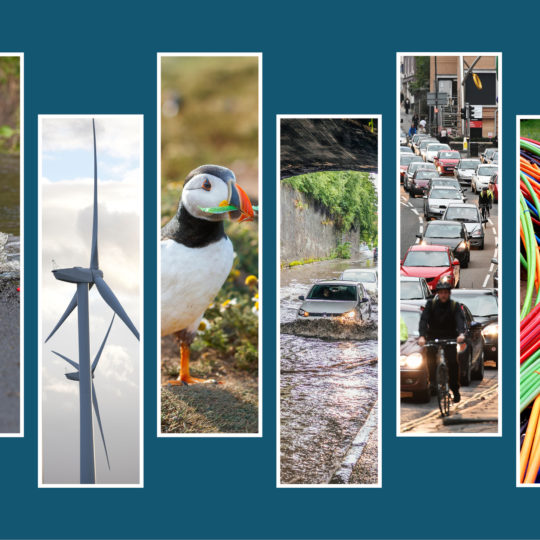
Status: Completed
Second National Infrastructure Assessment: Baseline Report
An analysis of the current state of key infrastructure sectors
Reports & StudiesDesign & Funding Digital & Data Energy & Net Zero Environment National Infrastructure Assessment Place Regulation & Resilience Transport Water & Floods
Latest Updates

Coming up in 2024
This page shows a calendar reflecting the latest expected dates for Commission reports, publications and events. You can also sign up to receive our quarterly newsletter by entering your email address in the box at the foot of each website page.
